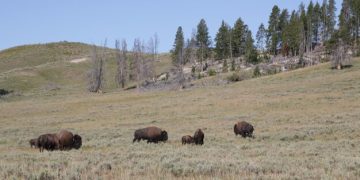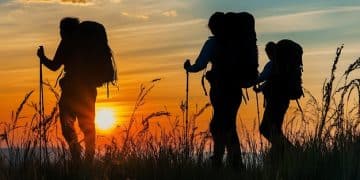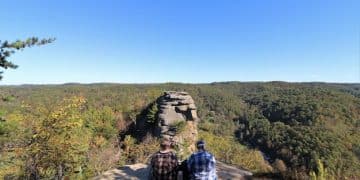National Park Safety: Essential Tips for Wildlife Encounters
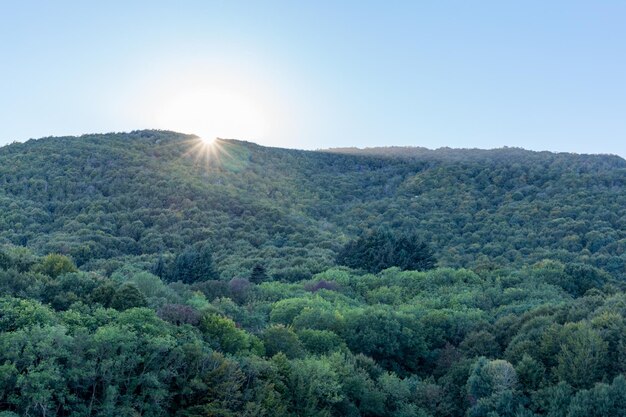
Ensuring safety in national parks involves understanding wildlife behavior, proper food storage, maintaining a safe distance, and knowing how to react to encounters, which are key to preventing incidents.
Exploring national parks offers incredible experiences, but it’s crucial to prioritize safety, especially when it comes to wildlife. This article provides national park safety: essential tips for avoiding wildlife encounters, so you can enjoy your visit while minimizing risks.
Understanding Wildlife Behavior
To ensure a safe visit to any national park, it’s important to understand the behavior of the wildlife you might encounter. Knowing how animals typically react can help you avoid dangerous situations and appreciate wildlife from a safe distance.
Each animal species has its own unique behaviors. Understanding the typical behaviors of animals like bears, bison, elk, and smaller creatures can help you to predict their actions and avoid surprising them.
Common Wildlife Behaviors
Here are some typical behaviors you might observe in national parks:
- Feeding patterns: Many animals are most active during dawn and dusk when they forage for food.
- Mating seasons: During these times, animals can be more aggressive and territorial.
- Defensive behaviors: Animals may display signs of aggression if they feel threatened or if their young are nearby.
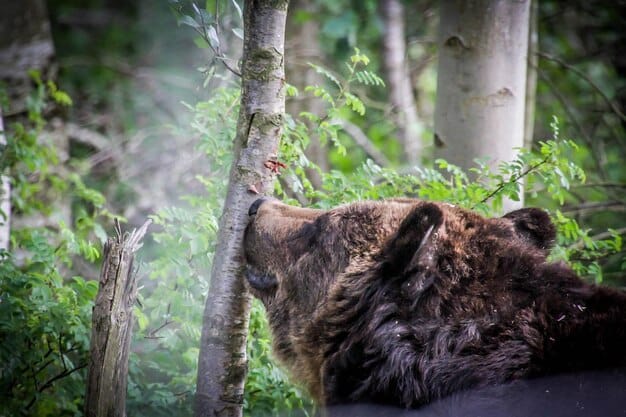
Understanding wildlife behavior is not only crucial for your safety but also for the well-being of the animals. By respecting their space and understanding their behaviors, you can minimize the risks of negative encounters.
Safe Food Storage Practices
Proper food storage is vital in national parks to prevent attracting wildlife to your campsite. When animals become habituated to human food, they can become aggressive and pose a threat to visitors.
Improperly stored food is a common attractant for animals like bears, raccoons, and rodents. Following specific guidelines for food storage helps keep both you and wildlife safe.
Approved Storage Methods
Here are some effective food storage methods:
Bear canisters, for example, are constructed from super-durable plastic, with smooth sides that bears can’t get their claws and teeth into. Once they think it’s not able to be opened or worth the trouble, they’ll move on. Other methods include:
- Bear-resistant canisters: These hard-sided containers prevent animals from accessing food.
- Bear hangs: Properly hanging food in bags suspended between trees.
- Designated food lockers: Some campgrounds provide steel lockers for secure food storage.
By employing best storage practices, you are helping keep both yourself and the park’s animals safe. Always check with the specific national park for approved storage methods.
Maintaining a Safe Distance
Keeping a safe distance from wildlife is one of the most important steps to prevent dangerous encounters. Animals in national parks are wild and unpredictable, and even seemingly docile creatures can pose a threat if approached too closely.
Maintaining a safe distance not only protects you but also reduces stress on the animals. Approaching wildlife can disrupt their natural behaviors and cause unnecessary stress.
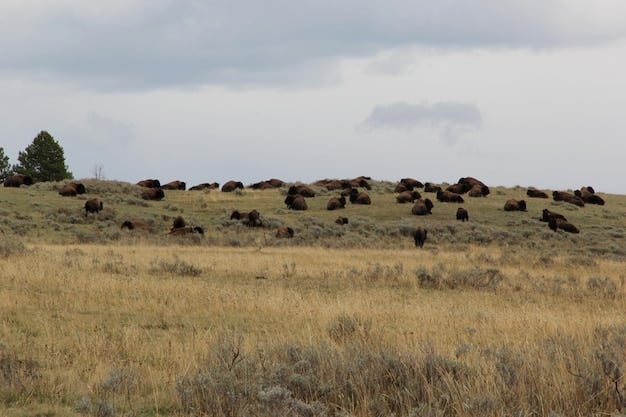
Recommended Distances
While each park has their own rules, here are some general guidelines for maintaining safe distances:
- Large Mammals: Stay at least 100 yards away from bears and wolves.
- Other Wildlife: Keep a distance of at least 25 yards from other animals, such as bison, elk, and deer.
- Birds: Avoid approaching nests or disturbing nesting sites.
Maintaining a safe distance shows respect for wildlife and helps ensure that both you and the animals remain unharmed. Remember, these are their homes so it is up to us to respect their space.
How to React During an Encounter
Despite best efforts, encounters with wildlife can happen. Knowing how to react during these situations can significantly reduce the risk of injury.
Your reaction to a wildlife encounter can determine the outcome. Remaining calm and following specific guidelines can help de-escalate tense situations.
Specific Response Strategies
Response strategies vary between species, here are some general rules of thumb when in a confrontation with varying species:
- Bears: Carry bear spray and know how to use it. If a bear approaches, stand your ground and make yourself look as large as possible. Back away slowly.
- Bison and Elk: Stay calm and avoid direct eye contact. Slowly move away, giving the animal plenty of space.
- Snakes: Give snakes a wide berth. If a snake strikes, seek immediate medical attention.
Knowing how to react during wildlife encounters is critical for preventing injuries and ensuring your safety. Always be prepared and stay informed about the specific wildlife in the area.
Essential Gear for Wildlife Safety
Carrying the right gear can significantly enhance your safety in national parks, particularly in areas with wildlife. The appropriate gear can help you prevent encounters, defend yourself if necessary, and signal for help.
Gear for wildlife safety includes defensive tools, communication devices, and navigational aids. Having these items available can make a big difference in managing encounters and emergencies.
Recommended Gear List
Here is a list of essential gear for wildlife safety:
- Bear spray: A highly effective deterrent against bears when used correctly.
- Air Horn or Whistle: Alarms can deter animals and attract human attention.
- First-aid kit: A kit can reduce the impact of bodily harm.
Carrying the right gear and knowing how to use it can significantly improve your safety in national parks. Equip yourself properly and stay vigilant during your visit.
Staying Informed and Aware
Staying informed about park-specific information and being aware of your surroundings are crucial for preventing wildlife encounters. National parks often provide valuable resources and guidelines to help ensure visitor safety.
Parks often have specific regulations and advisories related to wildlife activity. Being aware of these local guidelines can help you make informed decisions and stay safe.
Information Resources
Utilize these methods to keep yourself updated during visits:
- Park Rangers: Park Rangers are the first line of defense. They often have up-to-date information on incidents.
- Visitor Centers: Visit the visitor center before your trip to find out information on recent park activity.
- Park Websites and Apps: Check the official parks website for the park you are visiting as it will have information on current restrictions.
Staying informed and aware is essential for a safe and enjoyable visit to national parks. By utilizing available resources, you can minimize the risks and protect yourself and the wildlife.
| Key Point | Brief Description |
|---|---|
| 🐻 Understand Wildlife | Learn animal behaviors to avoid surprises. |
| 🍔 Safe Food Storage | Use bear canisters or food lockers to prevent attracting animals. |
| 📏 Maintain Distance | Stay at least 100 yards from bears and wolves. |
| 🚨 React Properly | Carry bear spray and know how to react to encounters calmly. |
Frequently Asked Questions
▼
If you encounter a bear, remain calm. Do not run. Make yourself look as large as possible, make noise, and slowly back away. If the bear attacks, use bear spray.
▼
Stay at least 100 yards away from bears and wolves. For other wildlife like bison, elk, and deer, maintain a distance of at least 25 yards.
▼
The best way to store food is by using bear-resistant canisters, hanging food in bear bags suspended between trees, or using designated food lockers where provided.
▼
Essential gear includes bear spray, a first-aid kit, a whistle, and navigation tools like a map and compass. A flashlight or headlamp can also be useful.
▼
You can obtain park-specific safety guidelines from park rangers, visitor centers, and the official website or app of the national park you plan to visit.
Conclusion
Prioritizing safety in national parks is essential for both visitors and wildlife. By following these tips on understanding animal behaviors, practicing safe food storage, maintaining a safe distance, carrying essential gear, staying informed, and knowing how to react during encounters, you can significantly reduce the risk of negative interactions and enjoy a safer, more enriching experience in the great outdoors.
